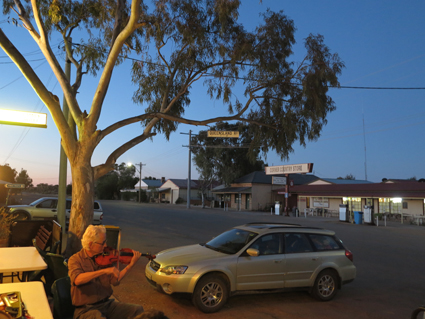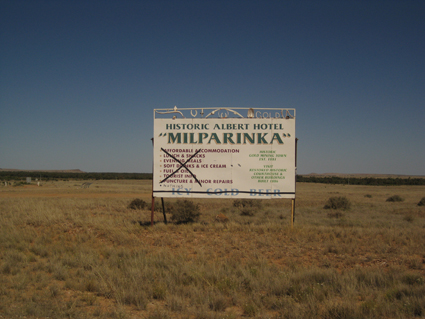on the road with rose
rishin singh: jon rose’s sound circus

Jon Rose in Tibooburra
photo Lucas Abela
Jon Rose in Tibooburra
FROM SEPTEMBER 3 TO 18 JON ROSE (VIOLIN & FENCES) AND HOLLIS TAYLOR (VIOLIN) INVITED EXPERIMENTAL MUSICIANS AND ARTISTS LUCAS ABELA (GLASS), LAURA ALTMAN (CLARINET), DALE GORFINKEL (VIBRAPHONE, MODIFIED TRUMPET & MOTORS), SAM PETTIGREW (FENCES, GUITAR & OBJECTS), KEG DE SOUZA (VISUAL ARTIST), JOEL STERN (FOOT PUMPS & FEEDBACK) AND ME (TROMBONE) TO TOUR CORNER COUNTRY IN FAR NORTH-WESTERN NSW AS PART OF SOUND CIRCUS. PERFORMANCES AND WORKSHOPS WERE HELD AT WHITE CLIFFS, MUTAWINTJI NATIONAL PARK, BROKEN HILL, MILPARINKA, TIBOOBURRA, WARRI GATE AND CAMERON CORNER.
*
The nagging question that followed me around on this tour was whether our aesthetics would change as we took our niche practices with us way out west.
*
September 15. The last performance date of the tour, Cameron Corner, is a pub/motel/campground/restaurant/golf course straddling the borders of New South Wales, Queensland and South Australia. Population: six. By the time we get there we all seem comfortable with our wide brimmed hats, body odours, dirty hands and tinnies of XXXX.
On a patch of hard orange dirt next to the road to the pub, Jon sets up his Ball Project: a two-metre high inflatable ball, which produces electronic sound in response to its movement via wireless technology and a portable PA system. At its last outing in Tibooburra some sort of malfunction occurred. It no longer produces any sound. Joel hooks up his mini-synth to the PA and replicates what he imagines to be the sounds created by the accelerometers inside the ball, as the performers and the publican run at, kick, head-butt, carry in the air, throw and drive cars at it.
As the sun sets over the golf course and desert, the giant ball rolls across the landscape alone except for a dog which tries to herd it. Over more tinnies, the publican offers to buy it. He wants to mount it on a giant tee as an advertisement for the golf course.
*
September 14. At some point our joking mimicry of a stereotypical outback drawl has become an unconscious accent we slip in out of, how blue we swear depending on who we’re talking to. Someone else’s words in my mouth.
*
September 13. Jon has been playing in the outback for many, many years. I think for him this turning towards the interior of the continent is a deeply considered political question of adaptation and reconciliation. The slow evolution of his music and the means of its production is an historical trajectory upon which at this point in time we have joined him. During the short time in which we’ve been playing in the outback I don’t think we can effectively measure how our movement across space has affected our aesthetics.
Having scratched the surface, today we argued about how we would organise Sound Circus next time—grand plans of lengthy residencies in remote communities where we would have more time to engage with people and the environment are bandied about as if adequate funding and available dates are already a concrete reality. Perhaps the desire to put ourselves in this position again is a sign of our musics slowly turning 180 degrees to the point where finally our backs will face the ocean.
September 12. Milparinka is a ghost town. As far as I can tell, its only residents are the two volunteers who live there temporarily to keep the tourism and heritage flame burning, and a house full of kangaroo hunters, who I never see or hear.
As the sun sets Laura, Sam, Dale, Joel and Jon play on the steps of the courthouse—a well maintained sandstone building housing historic artefacts, which doubles as our sleeping quarters for the night. Their improvisation is of a particular standard genre of gentle sounds and almost polite durations that allow space for other performers to contribute in a meaningful way. The music continues on this path until a very sudden and vicious swarm of mosquitoes descends on us in clouds, driving us into the courthouse, slapping at ourselves.
The move inside ends the improvisation and a new performance begins. Lucas, Jon and Joel play a louder improvisation, in different parts of the building, using sound to explore the resonance of the spaces. The simple placement of various vibrating apparatuses in specific points in the building creates a temporary architecture within the permanent architecture of the courthouse. I have to walk around the space in order to hear the piece in its entirety. Perhaps the inability to hear the other ensemble members encourages each performer to engage more with the space in which they play. Much later that night, Sam and I explore this idea further by locking ourselves in two adjoining police cells at the back of the courthouse and, with the lights out and a thick sandstone wall between us, improvise a piece to no audience other than a pair of microphones.
*

Milparinka
photo Laura Altman
Milparinka
September 11. Jon tells us we only have an hour for all seven of us to perform at Broken Hill Art Gallery because they have hired someone to work late to keep it open for us. We collectively discuss this, and decide that despite the time restrictions and the pressure to rush, we should let our performances develop organically. Throughout the tour we have been arguing about how best to respect an audience that is completely foreign to us and quite likely, in some instances, openly hostile. In particular, does a longer duration of performance test the patience of the audience, and, self-reflexively, does even questioning the patience of the audience instantly mean that we are not giving them the same respect that we would if they lived in a city? Jon says that no matter what, we’re here to entertain.
Line up: duos—Sam & Dale, Laura & Joel, Laura & Dale; trio—Joel, Sam, myself; solos—Joel, Lucas; installations—igloo with tape machines.
Despite the shorter durations, all the sets sound the way they would if we were performing at home, just truncated. Perhaps it is the safety and familiarity of a gallery setting that doesn’t challenge any aspect of our music.
At the end of Lucas’ blistering noise performance, the last of the night, an older lady at the back of the gallery exclaims “Ah, thank goodness!” This is followed by a formal question and answer session. The questions revolve around how our modified and self-invented instruments work.
*
September 9. The ball performance on the White Cliffs tennis court is cancelled due to high winds. Instead, a Radio National journalist asks if she can interview us. The interview turns into a discussion in which we press Jon to explain his intentions in inviting us to the outback with him. He wants to show us what excites him about playing in the outback, which he hopes will inspire us to regularly play there.
I ask Jon whether playing in the outback for all these years has changed the way he plays the violin. He says the violin is an inside instrument, which gets lost without four walls around it, so he began to change his playing technique—“effectively de-Europing himself,” I propose—to the point of abandoning playing the violin outside and focusing instead on playing fences and self-built instruments more suited to the conditions.
After the discussion Dale, Laura, Sam and I play a game of tennis. Even in the wind, Dale is very good.
*
September 8. Sam, Laura, Joel, Dale: a typical small-i improvised set in a dry creek bed. Quite restrained and delicate. The White Cliffs locals seem to like it. I am the first to clap when the performance ends. The local nurse—a large bearded man in an Akubra hat and Ganesh T-shirt—asks me how the hell I knew it was over. “They did that close eyes, open eyes, look up thing.” He tells me, “The silences were really a part of the music.”
*
September 7. We rehearse in White Cliffs community hall for our performance the next night as part of the Underground Arts Festival launch. We’re framed as a Sound Circus, “which makes us Sound Clowns” somebody jokes. Jon wants us to individually play 30-second interrupting segments of strange sounds during his and Hollis’ performance of folk tunes on the piano and singing saw. The general circus/vaudeville structure imposes duration on us which is antithetical to the way we usually play. (The next day, a couple of hours before our vaudeville act is to begin, Jon asks us if we want to back out. We collectively say yes.)
*
September 6. Over breakfast there are some concerns around how people are going to react to us. Sam wonders, “Are we here to entertain?” I say, “We’re not entertainers.” Lucas disagrees, he’s experimental and entertaining.
*
September 5. We arrive in White Cliffs in the middle of the night after driving through almost invisible cows and suicidal kangaroos down a narrow country road. We pull into the only pub in town, where we befriend a professional hunter, who sings the praises of vegetarianism, and the local tour guide whose deaf dog understands sign language.
*
Before we began the tour, I had a nagging question as to whether our aesthetics would change as we crossed the continent, taking our niche practices with us way out west.
Jon Rose and Hollis Taylor, Sound Circus, with Dale Gorfinkel, Lucas Abela, Keg de Souza, Joel Stern, Laura Altman, Rishin Singh, Sam Pettigrew, Hollis Taylor, Jon Rose, Corner Country NSW, Aug 24-Sept 17; http://www.jonroseweb.com/f_projects_sound_circus.html
See Jon Rose’s account of the Sound Circus over at the Australian Music Centre’s Resonate Magazine.
See RealTime’s archive highlight of the NOW now
This article first appeared in RT’s online e-dition Oct 23
RealTime issue #112 Dec-Jan 2012 pg. 42






